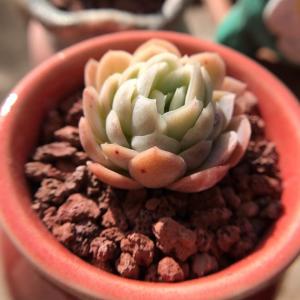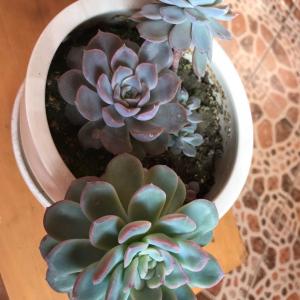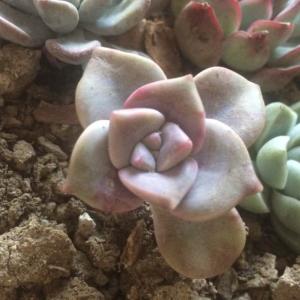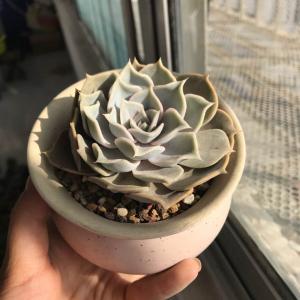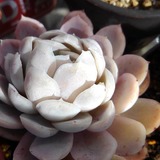文章
权问薇
2018年01月03日

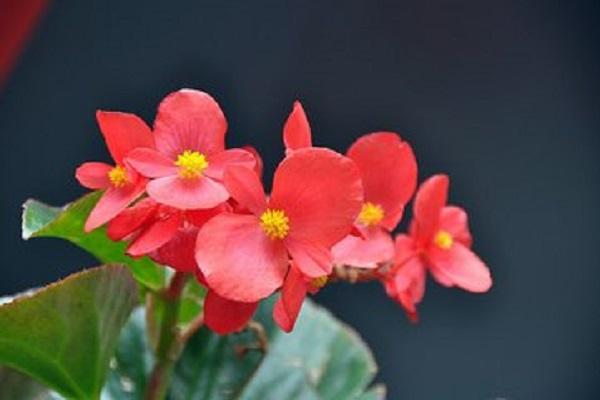
一、关于四季海棠花谢后的措施:
1.换土:四季海棠的基质可以用河沙混以腐叶,充分搅拌后调制,给四季海棠换一个适合的生长环境可以帮助它快速生长。
2.浇水:在四季海棠花谢后,我们应该减少浇水量,保持四季海棠的盆土略干燥。差不多每两天浇水一次,并经常向它的周围喷洒水雾,以提高空气湿度。还要注意的是,我们在浇水时不要自上而下地垂直地浇,而是要沿着四季海棠的花盆四周慢慢地浇。

3.施肥:在四季海棠花谢后,我们应根据四季海棠的叶子生长情况施加肥料。我们不能施过多的肥,否则叶片会白白生长,新花却不能生长
4.摘心:四季海棠在花谢后要及时摘心,去除残败的花,这样以后它新开的花就会更加茂盛。
5.修剪:在四季海棠在花开前,我们应适时修剪枝叶,以防止它们的消耗养分。修剪之后,它开出的花必定会更艳丽健康、光彩夺目。

二、关于四季海棠防止花谢的措施:
1.防冻:在冬季来临之前,我们要将四季海棠放置在室内温暖处。
2.防病:在夏季,四季海棠容易患上花谢病。我们发现病征出现后,就应该及时减少浇水量,持续一段时间即可减轻症状。
3.防虫害:卷叶蛾是引起四季海棠患病常见的害虫,这种幼虫会食害四季海棠的花。对于这种情况,如果不是特别的严重,我们可以选择人工捕捉。

1
1
文章
Miss Chen
2018年01月03日

Description: This herbaceous perennial plant is 4-7" tall, consisting of several basal leaves and one or more inflorescences. The basal leaves are trifoliate. The leaflets are up to 2½" long and 1½" across; they are obovate or oval in shape and coarsely toothed along their middle to outer margins. The tips of leaflets are rounded, while their bottoms are either wedge-shaped or rounded. The upper leaflet surface is medium to dark green and glabrous. The lower leaflet surface is variably hairy; fine hairs are most likely to occur along the bases of central veins, but they may occur elsewhere along the lower surface. Leaflet venation is pinnate and conspicuous. The petiolules (basal stalklets) of leaflets are light green, hairy, and very short (about 1 mm. in length). The petioles of basal leaves are up to 6" long; they are light green to light reddish green, terete, and hairy. One or more umbel-like clusters of flowers are produced from long peduncles up to 5" long. These peduncles are light green to light reddish green, terete, and hairy. Each umbel-like cluster has about 4-6 flowers on pedicels up to ¾" long. These pedicels are light green to light reddish green, terete, and hairy. At the base of these pedicels, there are several bracts up to ¼" long that are light green to dark red, lanceolate in shape, and hairy.
Individual flowers are about ½–¾" across when they are fully open; they can be pistillate, staminate, or perfect (staminate flowers are the least common). Each flower has 5 white petals, 5 green sepals, and 5 green sepal-like bracts. The petals are oval to orbicular in shape; they are longer than either the sepals or sepal-like bracts. The sepals are lanceolate in shape and hairy, while the sepal-like bracts are linear-lanceolate and hairy; both sepals and sepal-like bracts are joined together at the base of the flower. Each pistillate flower has a dome-shaped cluster of pistils at its center that is greenish yellow or pale yellow. Each staminate flower has 20-35 stamens with pale yellow filaments and yellow anthers. Each perfect flower has a dome-shaped cluster of pistils at its center and a ring of surrounding stamens. The blooming period occurs from late spring to early summer, lasting about 3-4 weeks. Afterwards, the flowers are replaced by fruits when growing conditions are favorable, otherwise they abort. These fruits are up to ½" long and across; they are globoid or globoid-ovoid in shape, becoming bright red at maturity. Small seeds are scattered across the surface of these fruits in sunken pits; the persistent sepals and sepal-like bracts are appressed to the upper surface of these fruits. The fleshy interior of these fruits has a sweet-tart flavor; they are edible. The root system consists of a shallow crown with fibrous roots. After the production of flowers and fruits, hairy above-ground stolons up to 2' long may develop from the crown. When the tips of these stolons touch the ground, they often form plantlets that take root. In this manner, clonal colonies of plants often develop.

Cultivation: The preference is full or partial sun, moist to dry-mesic conditions, and fertile soil containing loam or clay-loam. Wild Strawberry is a cool-season plant that grows actively during the spring and fall, but it often becomes dormant after setting fruit during the hot summer months. This plant is easy to cultivate, and it will spread to form a loose ground cover in open areas. The foliage is more resistant to foliar disease than most cultivated strawberries. While flowers are produced reliably every spring where there is adequate sunlight, the fruits may or may not develop, depending on the weather and environmental conditions. Watering plants during dry spells in late spring and early summer probably encourages fruits to develop. These fruits are much smaller in size than those of cultivated strawberries.
Range & Habitat: The native Wild Strawberry is common in most areas of Illinois, although in parts of NW and southern Illinois it is occasional or absent (see Distribution Map). Habitats include black soil prairies, hill prairies, bluegrass meadows, small meadows in wooded areas, open woodlands, woodland borders, savannas, limestone glades, roadsides, and areas along railroads. Wild Strawberry is able to tolerate competition from taller plants because it develops early in the spring, and it is able to tolerate some shade later in the year. This plant occurs in both degraded and high quality habitats, often not far from wooded areas.

Faunal Associations: The ecological value of Wild Strawberry to various insects, birds, and animals is high. The nectar and pollen of the flowers attract little carpenter bees (Ceratina spp.), cuckoo bees (Nomada spp.), mason bees (Osmia spp.), Halictid bees (including green metallic bees), Halictid cuckoo bees (Sphecodes spp.), Andrenid bees, Syrphid flies, thick-headed flies (Conopidae), Tachinid flies, bottle flies (Lucilia spp.), flesh flies (Sarcophagidae), small butterflies, and skippers (see Robertson, 1929, & others). These floral visitors are beneficial because they cross-pollinate the flowers. Other insects feed destructively on the foliage and other parts of Wild Strawberry. Caterpillars of the Grizzled Skipper (Pyrgus centaurae wyandot) feed on this plant. Other insect feeders include larvae of such moths as the Strawberry Crown Borer (Synanthedon bibionipennis), Strawberry Leafroller Moth (Ancylis comptana fragariae), and Wild Strawberry Seed Borer (Grapholita angleseana). The Moth Table has a more complete list of moth species that feed on this plant.

Other insect feeders include the Strawberry Flea Beetle (Altica ignita) and other leaf beetles (Chrysomelidae), the Strawberry Sap Beetle (Stelidota gemmata), the Strawberry Root Weevil (Otiorhynchus ovatus) and other weevils (Curculionidae), larvae of the Strawberry Reniform Gall Midge (Cecidomyia reniformis), larvae of the Strawberry Cylindrical Gall Wasp (Diastrophus fragariae), larvae of the Curled Rose Sawfly (Allantus cinctus) and other sawflies, the Strawberry Aphid (Chaetosiphon fragaefolii) and other aphids, and flower thrips. The Insect Table has a more complete list of insect species that feed on this plant. Various vertebrate animals eat the fruits and foliage of Wild Strawberry. Many upland gamebirds and songbirds eat the fruits, including the Ring-necked Pheasant, Greater Prairie Chicken, Brown Thrasher, Eastern Towhee, and American Robin. Some mammals, including the Opossum, Eastern Skunk, Franklin Ground Squirrel, Eastern Chipmunk, and White-footed Mouse, also eat the fruits, as do the Eastern Box Turtle, Ornate Box Turtle, and Wood Turtle. By eating the fruits, these animals spread the seeds to new locations. The foliage of Wild Strawberry is a source of food for the Cottontail Rabbit, White-tailed Deer, Groundhog, and Meadow Vole. The foliage is also browsed by horses, cattle, sheep, and goats. The Wildlife Table has a more complete list of vertebrate animals that feed on this plant.

Photographic Location: The photographs were taken along a roadside near Urbana, Illinois; at Dave Monk's postage stamp prairie in Champaign, Illinois; and at the wildflower garden of the webmaster in Urbana, Illinois.
Comments: This is one of the parent plants for the cultivated strawberry (Fragaria × ananassa). The other parent plant of the cultivated strawberry is the Coastal Strawberry (Fragaria chiloensis). This latter species is found along the Pacific Coast in both North and South America. The cultivated strawberry inherited the superior flavor of the Wild Strawberry (Fragaria virginiana) and the larger fruit size of the Coastal Strawberry. The Wild Strawberry produces attractive white flowers during the spring and small red fruits during the early summer. It is similar in appearance to another native species, the Hillside Strawberry (Fragaria vesca americana). The fruits of Hillside Strawberry have sepals and sepal-like bracts that are spreading to reflexed, rather than appressed. The fruits of Hillside Strawberry also have seeds scattered on top of their surfaces, rather than enclosed in shallow pits. This strawberry species is found in northern Illinois, where it is uncommon. It is closely related to the Alpine Strawberry (Fragaria vesca vesca), which is found in Europe.
Individual flowers are about ½–¾" across when they are fully open; they can be pistillate, staminate, or perfect (staminate flowers are the least common). Each flower has 5 white petals, 5 green sepals, and 5 green sepal-like bracts. The petals are oval to orbicular in shape; they are longer than either the sepals or sepal-like bracts. The sepals are lanceolate in shape and hairy, while the sepal-like bracts are linear-lanceolate and hairy; both sepals and sepal-like bracts are joined together at the base of the flower. Each pistillate flower has a dome-shaped cluster of pistils at its center that is greenish yellow or pale yellow. Each staminate flower has 20-35 stamens with pale yellow filaments and yellow anthers. Each perfect flower has a dome-shaped cluster of pistils at its center and a ring of surrounding stamens. The blooming period occurs from late spring to early summer, lasting about 3-4 weeks. Afterwards, the flowers are replaced by fruits when growing conditions are favorable, otherwise they abort. These fruits are up to ½" long and across; they are globoid or globoid-ovoid in shape, becoming bright red at maturity. Small seeds are scattered across the surface of these fruits in sunken pits; the persistent sepals and sepal-like bracts are appressed to the upper surface of these fruits. The fleshy interior of these fruits has a sweet-tart flavor; they are edible. The root system consists of a shallow crown with fibrous roots. After the production of flowers and fruits, hairy above-ground stolons up to 2' long may develop from the crown. When the tips of these stolons touch the ground, they often form plantlets that take root. In this manner, clonal colonies of plants often develop.

Cultivation: The preference is full or partial sun, moist to dry-mesic conditions, and fertile soil containing loam or clay-loam. Wild Strawberry is a cool-season plant that grows actively during the spring and fall, but it often becomes dormant after setting fruit during the hot summer months. This plant is easy to cultivate, and it will spread to form a loose ground cover in open areas. The foliage is more resistant to foliar disease than most cultivated strawberries. While flowers are produced reliably every spring where there is adequate sunlight, the fruits may or may not develop, depending on the weather and environmental conditions. Watering plants during dry spells in late spring and early summer probably encourages fruits to develop. These fruits are much smaller in size than those of cultivated strawberries.
Range & Habitat: The native Wild Strawberry is common in most areas of Illinois, although in parts of NW and southern Illinois it is occasional or absent (see Distribution Map). Habitats include black soil prairies, hill prairies, bluegrass meadows, small meadows in wooded areas, open woodlands, woodland borders, savannas, limestone glades, roadsides, and areas along railroads. Wild Strawberry is able to tolerate competition from taller plants because it develops early in the spring, and it is able to tolerate some shade later in the year. This plant occurs in both degraded and high quality habitats, often not far from wooded areas.

Faunal Associations: The ecological value of Wild Strawberry to various insects, birds, and animals is high. The nectar and pollen of the flowers attract little carpenter bees (Ceratina spp.), cuckoo bees (Nomada spp.), mason bees (Osmia spp.), Halictid bees (including green metallic bees), Halictid cuckoo bees (Sphecodes spp.), Andrenid bees, Syrphid flies, thick-headed flies (Conopidae), Tachinid flies, bottle flies (Lucilia spp.), flesh flies (Sarcophagidae), small butterflies, and skippers (see Robertson, 1929, & others). These floral visitors are beneficial because they cross-pollinate the flowers. Other insects feed destructively on the foliage and other parts of Wild Strawberry. Caterpillars of the Grizzled Skipper (Pyrgus centaurae wyandot) feed on this plant. Other insect feeders include larvae of such moths as the Strawberry Crown Borer (Synanthedon bibionipennis), Strawberry Leafroller Moth (Ancylis comptana fragariae), and Wild Strawberry Seed Borer (Grapholita angleseana). The Moth Table has a more complete list of moth species that feed on this plant.

Other insect feeders include the Strawberry Flea Beetle (Altica ignita) and other leaf beetles (Chrysomelidae), the Strawberry Sap Beetle (Stelidota gemmata), the Strawberry Root Weevil (Otiorhynchus ovatus) and other weevils (Curculionidae), larvae of the Strawberry Reniform Gall Midge (Cecidomyia reniformis), larvae of the Strawberry Cylindrical Gall Wasp (Diastrophus fragariae), larvae of the Curled Rose Sawfly (Allantus cinctus) and other sawflies, the Strawberry Aphid (Chaetosiphon fragaefolii) and other aphids, and flower thrips. The Insect Table has a more complete list of insect species that feed on this plant. Various vertebrate animals eat the fruits and foliage of Wild Strawberry. Many upland gamebirds and songbirds eat the fruits, including the Ring-necked Pheasant, Greater Prairie Chicken, Brown Thrasher, Eastern Towhee, and American Robin. Some mammals, including the Opossum, Eastern Skunk, Franklin Ground Squirrel, Eastern Chipmunk, and White-footed Mouse, also eat the fruits, as do the Eastern Box Turtle, Ornate Box Turtle, and Wood Turtle. By eating the fruits, these animals spread the seeds to new locations. The foliage of Wild Strawberry is a source of food for the Cottontail Rabbit, White-tailed Deer, Groundhog, and Meadow Vole. The foliage is also browsed by horses, cattle, sheep, and goats. The Wildlife Table has a more complete list of vertebrate animals that feed on this plant.

Photographic Location: The photographs were taken along a roadside near Urbana, Illinois; at Dave Monk's postage stamp prairie in Champaign, Illinois; and at the wildflower garden of the webmaster in Urbana, Illinois.
Comments: This is one of the parent plants for the cultivated strawberry (Fragaria × ananassa). The other parent plant of the cultivated strawberry is the Coastal Strawberry (Fragaria chiloensis). This latter species is found along the Pacific Coast in both North and South America. The cultivated strawberry inherited the superior flavor of the Wild Strawberry (Fragaria virginiana) and the larger fruit size of the Coastal Strawberry. The Wild Strawberry produces attractive white flowers during the spring and small red fruits during the early summer. It is similar in appearance to another native species, the Hillside Strawberry (Fragaria vesca americana). The fruits of Hillside Strawberry have sepals and sepal-like bracts that are spreading to reflexed, rather than appressed. The fruits of Hillside Strawberry also have seeds scattered on top of their surfaces, rather than enclosed in shallow pits. This strawberry species is found in northern Illinois, where it is uncommon. It is closely related to the Alpine Strawberry (Fragaria vesca vesca), which is found in Europe.
0
0
文章
Miss Chen
2018年01月03日

Description: This herbaceous perennial plant is 2-3½' tall. Sometimes it is slender and little branched, while at other times it branches frequently, creating a bushy appearance. The slender stems usually have lines of fine white hairs. The alternate leaves are linear and have smooth margins. The larger leaves have 3 conspicuous veins, although the smaller ones usually have only a single conspicuous vein. They are up to 4" long and 3/8" across, or slightly wider. Sometimes there are a few white hairs near the base of the leaves and along the central vein on the underside. There are clusters of small composite flowers at the apex of the plant and many of the upper side stems. These flower clusters are usually rather flat-headed, but they sometimes assume a round-headed appearance. Each composite flower is yellow, consisting of about 21-35 disk florets and ray florets (when considered together). It is only about 1/8" across – smaller than the composite flowers of other goldenrods.
These compound flowers often bloom gradually, rather than simultaneously, with older flowers turning brown while younger flowers are still in the bud stage. The blooming period is late summer to early fall, and lasts about 1 month. Sometimes there is a mild floral scent. The root system is fibrous, and new plants develop vegetatively from rhizomes. Overall, Grass-Leaved Goldenrod is rather variable across different localities.
Cultivation: The preference is full sun and moist conditions. However, this plant tolerates drier conditions, and can be surprisingly drought tolerant. The soil should contain high amounts of organic matter; some varieties of this plant also grow in moist sandy soil. Powdery mildew seems to bother this goldenrod less often than many others. It is easy to grow, but can spread aggressively in moist sunny places.

Range & Habitat: Grass-Leaved Goldenrod occurs occasionally in most counties of Illinois (see Distribution Map), where this plant is native. However, it can be locally common in some wetlands areas. Habitats include moist black soil prairies, edges of marshes, sandy pannes between dunes, calcareous seeps, borders of lakes, abandoned fields, and ditches along railroads. Grass-Leaved Goldenrod occasionally occurs in drier habitats, but it has greater trouble competing with other forbs, such as Solidago canadensis (Canada Goldenrod), in such places.
Faunal Associations: The small flowers attract many kinds of insects, including long-tongued bees, short-tongued bees, wasps, flies, butterflies, moths, and beetles. Various wasps and a few beetle species, such as Chauliognathus pennsylvanicus (Goldenrod Soldier Beetle) and Epicauta pensylvanica (Black Blister Beetle), seem to be especially attracted to the flowers. The caterpillars of several species of moths eat various parts of this and other goldenrods (see Moth Table). The seeds are eaten by the Eastern Goldfinch and Swamp Sparrow to a limited extent, while the foliage is occasionally consumed in limited amounts by the Greater Prairie Chicken, Cottontail Rabbit, and White-Tailed Deer.

Photographic Location: The photographs were taken at Meadowbrook Park in Urbana, Illinois.
Comments: Grass-Leaved Goldenrod has more slender leaves than other goldenrods in Illinois, except for Euthamia gymnospermoides (Plains Grass-Leaved Goldenrod). However, there is only a single conspicuous vein in the largest leaves of this latter species, its stems are hairless, it has only 12-20 disk and ray florets in a compound flower (when considered together), and it is usually more branched and bushy in appearance. Grass-Leaved Goldenrod also differs from the latter species by preferring more soggy habitats.
These compound flowers often bloom gradually, rather than simultaneously, with older flowers turning brown while younger flowers are still in the bud stage. The blooming period is late summer to early fall, and lasts about 1 month. Sometimes there is a mild floral scent. The root system is fibrous, and new plants develop vegetatively from rhizomes. Overall, Grass-Leaved Goldenrod is rather variable across different localities.
Cultivation: The preference is full sun and moist conditions. However, this plant tolerates drier conditions, and can be surprisingly drought tolerant. The soil should contain high amounts of organic matter; some varieties of this plant also grow in moist sandy soil. Powdery mildew seems to bother this goldenrod less often than many others. It is easy to grow, but can spread aggressively in moist sunny places.

Range & Habitat: Grass-Leaved Goldenrod occurs occasionally in most counties of Illinois (see Distribution Map), where this plant is native. However, it can be locally common in some wetlands areas. Habitats include moist black soil prairies, edges of marshes, sandy pannes between dunes, calcareous seeps, borders of lakes, abandoned fields, and ditches along railroads. Grass-Leaved Goldenrod occasionally occurs in drier habitats, but it has greater trouble competing with other forbs, such as Solidago canadensis (Canada Goldenrod), in such places.
Faunal Associations: The small flowers attract many kinds of insects, including long-tongued bees, short-tongued bees, wasps, flies, butterflies, moths, and beetles. Various wasps and a few beetle species, such as Chauliognathus pennsylvanicus (Goldenrod Soldier Beetle) and Epicauta pensylvanica (Black Blister Beetle), seem to be especially attracted to the flowers. The caterpillars of several species of moths eat various parts of this and other goldenrods (see Moth Table). The seeds are eaten by the Eastern Goldfinch and Swamp Sparrow to a limited extent, while the foliage is occasionally consumed in limited amounts by the Greater Prairie Chicken, Cottontail Rabbit, and White-Tailed Deer.

Photographic Location: The photographs were taken at Meadowbrook Park in Urbana, Illinois.
Comments: Grass-Leaved Goldenrod has more slender leaves than other goldenrods in Illinois, except for Euthamia gymnospermoides (Plains Grass-Leaved Goldenrod). However, there is only a single conspicuous vein in the largest leaves of this latter species, its stems are hairless, it has only 12-20 disk and ray florets in a compound flower (when considered together), and it is usually more branched and bushy in appearance. Grass-Leaved Goldenrod also differs from the latter species by preferring more soggy habitats.
0
0





